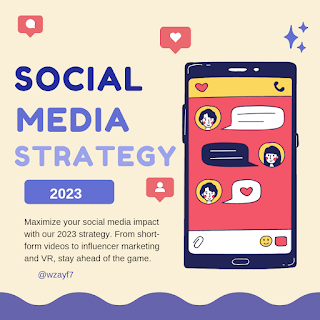In 2023, social media will continue to play a critical role in digital marketing. Here are some key strategies to consider:
- Identify and prioritize social media channels that align with your brand values, target audience, and goals.
- Incorporate short-form videos, especially Reels and TikTok, into your content mix.
- Create authentic and real-time posts that resonate with your audience, rather than overly edited or filtered content.
- Use influencer marketing to generate leads, expand your reach, and engage with your target audience, focusing on a mix of micro and macro-influencers or smaller influencers only.
- Encourage engagement and interaction with your followers by using new features like reaction stickers, Q&A on Stories and Reels, and TikTok video stitching.
- Explore the integration of virtual reality and artificial intelligence technologies to enhance the customer experience and create immersive brand experiences.
- Leverage social commerce features like shoppable posts, product tagging, and in-app checkout to increase conversions and drive revenue.
- Use data and analytics to track and measure the success of your social media campaigns, adjust your strategy accordingly, and optimize your performance.
Remember, your social media strategy should be flexible to stay ahead of evolving trends and adapt to changes in your target audience's behavior and preferences.
Identify and Prioritize Social Media Channels
When developing a social media strategy for 2023, it's important to identify and prioritize the social media channels that align with your brand values, target audience, and goals. Here are some steps to take:
- Define your brand values and target audience: What kind of message do you want to convey? Who is your target audience?
- Research social media channels: Look at the demographics and usage statistics of various social media platforms to see which ones align with your brand values and target audience.
- Choose your top social media channels: Once you have identified the social media platforms that align with your brand values and target audience, prioritize them based on their potential impact and relevance to your goals.
- Develop platform-specific strategies: Each social media platform has its own unique features and requirements, so it's important to develop platform-specific strategies that leverage the strengths of each platform while maintaining consistency with your brand values and messaging.
Incorporate Short-Form Videos
Short-form videos have taken over social media and are a great way to connect with your audience. Platforms like Reels and TikTok allow you to create fun, engaging videos that are perfect for grabbing attention and increasing engagement.
Here are some tips for incorporating short-form videos into your content mix:
- Keep it short and sweet - aim for videos under a minute long
- Be creative - use music, filters, and special effects to make your videos stand out
- Showcase your brand - incorporate your brand's colors, logo, and messaging into your videos
- Stay on trend - keep up with popular hashtags and challenges to stay relevant
Create Authentic and Real-Time Posts
When it comes to social media, authenticity is key. Consumers are more likely to engage with content that feels genuine and relatable. To create authentic content, focus on being transparent, vulnerable, and relatable. Don't be afraid to show the human side of your brand.
In addition, real-time posts are becoming increasingly important. Consumers want to feel connected to brands in the moment, so creating timely and relevant content is crucial. This means staying up-to-date with current events and industry news, and being quick to respond to trends and conversations on social media.
Use Influencer Marketing to Boost Your Social Media Strategy
Influencer marketing has become an increasingly popular way to reach new audiences and boost engagement on social media. By partnering with influencers, you can leverage their loyal following and tap into their expertise to create content that resonates with your target audience. But how do you go about selecting the right influencers for your brand and campaign?
Choosing the Right Influencers
When selecting influencers, it's important to consider their relevance to your brand, their reach, and their engagement with their audience. You should also evaluate their authenticity and trustworthiness, as these factors can affect how their followers perceive your brand.
One popular approach is to work with a mix of micro and macro-influencers. Micro-influencers typically have smaller followings, but their audiences are often more niche and engaged. On the other hand, macro-influencers have larger followings, but their audiences may be more general and less engaged. By working with a mix of both, you can reach a wider range of people while also targeting more specific audiences.
Crafting Your Influencer Campaign
When crafting your influencer campaign, be sure to clearly communicate your goals and expectations to your influencers. Consider collaborating with them on the creative process to ensure that the content they produce aligns with your brand values and resonates with their audience.
It's also important to track and measure the success of your influencer campaign to determine its impact on your social media strategy. Use metrics such as engagement rates, click-through rates, and conversion rates to evaluate the effectiveness of your campaign and make adjustments as needed.
Final Thoughts about Influencer marketing
Influencer marketing can be a powerful tool in your social media strategy, but it's important to choose the right influencers and create content that aligns with your brand values and resonates with your target audience. By working with a mix of micro and macro-influencers and tracking the success of your campaigns, you can effectively generate leads, expand your reach, and engage with your audience on social media.
Encourage Engagement and Interaction
Keep your followers engaged by using the latest social media features like:
- Reaction stickers
- Q&A on Stories and Reels
- TikTok video stitching
Make sure to use these features frequently to keep your followers interested and connected to your brand.
Explore the Integration of Virtual Reality and Artificial Intelligence Technologies
As technology continues to evolve, brands can leverage the power of virtual reality (VR) and artificial intelligence (AI) to enhance the customer experience and create immersive brand experiences.
Using VR technology, brands can create virtual environments where customers can interact with products and services in a unique and engaging way. This can be particularly effective in industries like real estate, tourism, and entertainment.
AI, on the other hand, can be used to personalize the customer experience by analyzing customer data and behavior. Brands can use AI-powered chatbots to provide personalized recommendations and support to customers in real-time.
By exploring the integration of these technologies, brands can create innovative and memorable experiences that stand out in the crowded digital landscape.
Brands Using VR and AI in Social Media
Leverage Social Commerce Features to Increase Conversions and Drive Revenue
With the rise of social media, brands can now leverage social commerce features to drive revenue and increase conversions. By incorporating shoppable posts, product tagging, and in-app checkout, brands can make it easier for customers to discover and purchase their products directly from social media platforms.
Track and Measure Social Media Campaign Success with Data and Analytics
By leveraging data and analytics, you can gain valuable insights into your social media performance and adjust your strategy accordingly. Here are some tips:
- Set specific goals and KPIs for each social media campaign
- Use social media analytics tools like Facebook Insights, Twitter Analytics, and Instagram Insights to track engagement, reach, and conversions
- Regularly review and analyze your data to identify trends, patterns, and areas for improvement
- Use A/B testing to experiment with different approaches and see what works best
- Adjust your strategy based on your findings to optimize your performance and drive better results
Conclusion
- Identify and prioritize social media channels that align with your brand values, target audience, and goals.
- Incorporate short-form videos, such as Reels and TikTok, into your content mix to engage your audience with snackable content.
- Create authentic and real-time posts that resonate with your audience, rather than overly edited or filtered content, to build trust and loyalty.
- Use influencer marketing to generate leads, expand your reach, and engage with your target audience, focusing on a mix of micro and macro-influencers to leverage their authority and authenticity.
- Encourage engagement and interaction with your followers by using new features like reaction stickers, Q&A on Stories and Reels, and TikTok video stitching.
- Explore the integration of virtual reality and artificial intelligence technologies to enhance the customer experience and create immersive brand experiences that stand out.
- Leverage social commerce features like shoppable posts, product tagging, and in-app checkout to increase conversions and drive revenue.
- Use data and analytics to track and measure the success of your social media campaigns, adjust your strategy accordingly, and optimize your performance to achieve your goals.
Remember, your social media strategy should be flexible to stay ahead of evolving trends and adapt to changes in your target audience's behavior and preferences.



0 comments:
Post a Comment